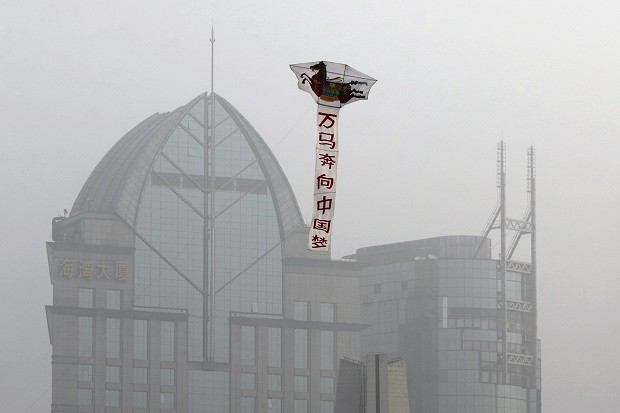
A kite baring a horse painting with words “Million of horses rushing toward China Dream” flies against office buildings at the Shanghai Bund in Shanghai, China, Thursday, April 14, 2016. World finance officials who meet in Washington this week confront a bleak picture: Eight years after the financial crisis erupted, the global economy remains fragile and at risk of another recession. AP
UNITED NATIONS — The United Nations lowered its forecast for the world economy on Thursday, painting a bleak picture of stagnating growth with little prospect for a turnaround this year.
The UN report on the World Economic Situation and Prospects as of mid-2016 forecasts overall global growth of just 2.4 percent this year, the same as last year. It represents a significant drop from the 2.9 percent growth the UN forecast for this year in its report last December.
“The bleak state of the world economy clearly poses significant challenges for member states around the world,” Assistant Secretary-General Lenni Montiel told a news conference launching the report.
He said forecasts for many countries in Africa and Latin America as well as for Russia and many of the former Soviet republics have been revised downward over the past few months.
The report blames a host of factors for this year’s lackluster economic prospects including persistent weak demand in the major economies which remains a drag on global growth, the low price of oil and other commodities which are hurting exporting countries, severe weather-related shocks especially severe drought related to El Niño, political challenges, and large capital outflows in many developing regions.
READ: Crafting of El Niño strategies pushed
Dawn Holland, a senior economist in the UN Department of Economic and Social Affairs, said the 2.4 percent growth predicted for this year is 1 percent lower than the average annual rate of growth of 3.4 percent in the decade leading up to the global financial crisis in 2008 and 2009. It reflects the weak global economy for most of the last decade, she said.
For 2017, Monteil said, “the global economy is projected to expand by 2.8 percent, marking a very modest improvement — and possibly reflecting the downturn bottoming out in some emerging economies.”
But he stressed that for the world economy to grow it needs increased investment and greater fiscal stimulus coordinated by the major economies who have relied for too long only on monetary stimulus like interest rates.
Holland said so far there are no proposals for coordinated fiscal stimulus measures, but the issue will be discussed at the upcoming summit of the Group of Seven major industrial powers in Japan on May 26-27.
The report highlights the prolonged economic downturns in Brazil and Russia, both with significant regional spillovers.
In Russia, GDP is forecast to contract by 1.9 percent in 2016 due to fiscal tightening, further declines in private consumption and investment, and continuing international sanctions, it said.
In Brazil, where President Dilma Rousseff in facing impeachment, the UN is projecting that the economy will contract by 3.4 percent this year, reflecting the deepening political crisis, rising inflation, a surging fiscal deficit and high interest rates.
READ: Brazil president faces impeachment over creative accounting
The world’s poorest countries are expected to grow by 4.8 percent in 2016 and 5.5 percent in 2017 but the report stressed that these figures are far below the UN target of at least 7.7 percent growth needed to increase spending on health care, education and measures to combat climate change.
The rich developed countries are not expected to see an improvement in GDP over last year, and in the United States the UN is predicting a drop in growth from 2.4 percent in 2015 to 2.2 percent this year due to weak business investment and low exports. Next year, the US economy is forecast to rise slightly to 2.5 percent.
The report said “economic growth in Africa continues to lose momentum, as it is buffeted by global, regional and internal headwinds.” GDP growth for the continent slowed to 3 percent last year and is expected to weaken more this year to 2.8 percent though east Africa is expected to see 6.1 percent growth.
Latin America and the Caribbean are expected to see the region’s economies contract by 0.6 percent for the second straight year, according to the report.
Holland said this would be the first two-year contraction since the debt crisis of 1982-83. She cited high inflation, high interest rates, rising unemployment, rising fiscal deficits “and a loss in confidence which is holding back investment” in some South American countries.
On a positive note, east Asia is projected to see 5.5 percent economic growth this year, with China’s economy forecast to grow by 6.4 percent in 2016 and 6.5 percent in 2017, in line with government targets, the report said.
RELATED STORIES
#InquirerSeven Most Vital Signs of Stronger Prospects for 2016
Brexit will hurt world economy — US Treasury chief